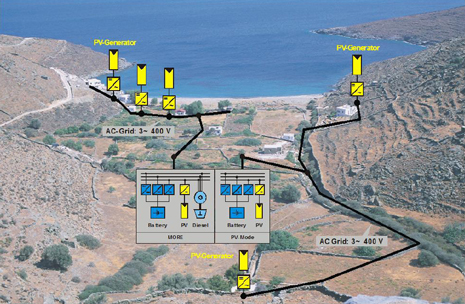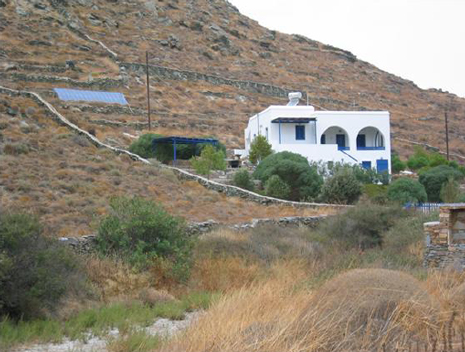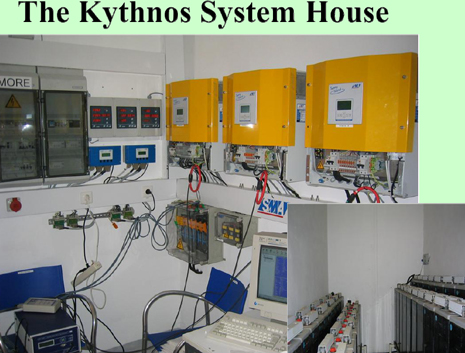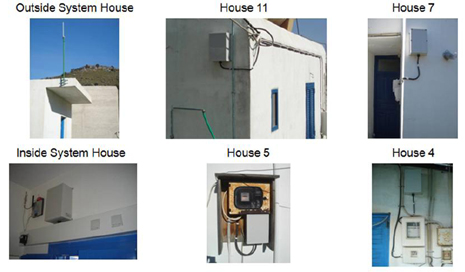 |
Kythnos micro gridLaatst geactualiseerd op 30 november 2009Eilanden en recreatieparken krijgen van de EU nog de ruimte om zich niet te laten overmeesteren door EdF en EON. Zo mag het Griekse Kythnos ook wat experimenteren met decentrale energieonafhankelijkheid.
Kythnos. Supply of 12 buildings. Eén van de 12 aangesloten huizen op Kythnos
Technische uitdagingen
Load controlZon genoeg op Kythnos. Maar je moet de energie zo veel mogelijk gebruiken als die beschikbaar is. Belangrijke verbruikers zijn de waterpompen. Door de werking van deze pompen af te stemmen op de beschikbaarheid van zonnestroom kan diesel worden bespaard. Daartoe worden de 12 huizen uitgerust met een systeem voor load control.
Wat hebben ze geleerd op Kythnos?
Dus eigenlijk: de schaal van 12 woningen is te klein. Toch maar beter werken op meso niveau? En verder?
Dus dit soort experimenten moet je niet op vakantie-eilanden doen. Maar gewoon op grote schaal, in een real life omgeving en op professionele wijze. Jammer dat de EU het alleen laat gebeuren in recreatieparken en op eilanden :-( Geschikt voor toepassing op grotere schaal
KEMA over KythnosAn interesting example of a micro-grid scheme that has been successfully deployed is in a
small valley on the Greek Island of Kythnos. The system in Gaidouromantra, is a single
phase micro-grid composed of the overhead power lines and a communication cable running
in parallel electrifying 12 houses. This network is used to test centralised and decentralised The innovation was initiated by a combination of a manufacturer and research institutions. The manufacturer was developing products for the operation of power electronics for autonomous electricity supply systems and needed a field application to test and develop the hardware and control strategies. The research institutions contributed to the development of the micro grid concept, the control strategies, the monitoring and the analysis of the data. The commercial driver comes from the social and environmental need for the electrification of small settlements in remote areas based on local renewable resources, mainly Renewable Energy Sources, where conventional power supply systems are too expensive to install, operate and maintain. The benefits obtained from the project were technical, scientific and commercial for the involved institutions and local residents report they are satisfied from the electricity service provided. The power electronics manufacturer (DC to AC inverter6) gained experience for the developed products and owing to the publicity and good operation of the system has opened new markets. We understand that several hundred new installations of similar inverter systems have followed, which is an example of paving the way for roll-out. With the experience and knowledge gained, research institutions have gone on to participate in new R&D projects broadening their expertise. It is reported that one of the challenges that occurred during the implementation was the fact
that consumers were not adequately involved in the management of the micro-grid and as
such they had the tendency to overload the system. This led to some shut downs in the
summer period, when all the residents are present and increase the energy demand. It was
found that the consumers do not have the necessary technical competence to take over the
responsibility for managing the electrical micro-grid system even at a basic level. Currently
there isn’t a viable scheme for the operation of the system by the users, which may be a key
issue to address for remotely located systems. The energy supply follows the model of the regular energy service provided by the local electricity utility, although the network conditions The initial installation was financially supported by a European Union program (JOULE) followed by further financial support within the EU Framework Program VI. The investment cost in terms of hardware and installation of the infrastructure including a 3-phase low voltage grid with a total length of about 700 m for the electrification of 12 holiday houses was €280,000. This excludes the cost of monitoring equipment and the work of the engineers of the project consortium institutions that designed and implemented the project.
|
Lokale elektriciteitsnetwerken (LEN)
|
|
Informatie op deze website wordt niet geactualiseerd. Ze is met de nodige zorgvuldigheid tot stand gekomen. Ze is echter geen alternatief voor gedetailleerd advies in specifieke omstandigheden. Alle teksten zijn geschreven op persoonlijke titel van de auteur(s) en reflecteren niet noodzakelijk de zienswijze van de site-eigenaar of van welke andere natuurlijke of rechtspersoon dan ook. Eventuele onjuistheden zijn niet uit te sluiten. Vragen en reacties zijn welkom op info@nieuwenuts.nl. NieuweNuts.nl is mede mogelijk gemaakt door Elannet BV en InnovatieNetwerk. |




